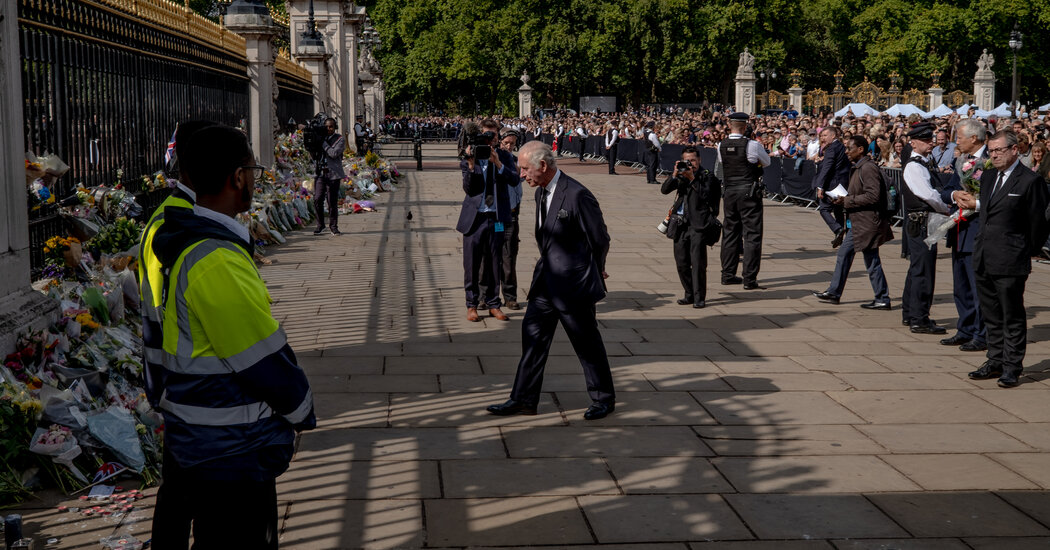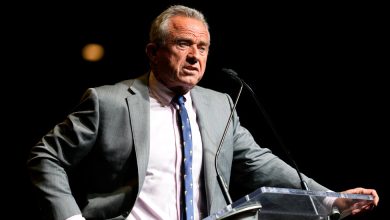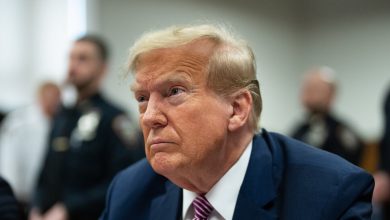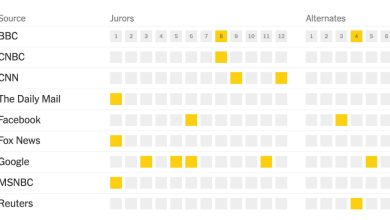
Charles, in First Speech as King, Pledges a Reign of Service to Britain
LONDON — Swiftly taking on the mantle of Britain’s monarch, King Charles III returned to London from Scotland on Friday, a day after the death of Queen Elizabeth II, to pledge that he would serve the British people “with loyalty, respect and love, as I have throughout my life.”
The king’s speech capped a day of mourning across Britain, but it was also a vivid demonstration of continuity in this constitutional monarchy. He met with the new prime minister, Liz Truss, just four days after the queen anointed her at Balmoral Castle, in the last official act of her seven-decade reign.
“Queen Elizabeth was a life well lived, a promise with destiny kept,” Charles said in a televised address that was at once dignified and deeply emotional, a son’s grieving eulogy for his mother and a sovereign’s solemn oath of duty.
Recalling Elizabeth’s vow, on her 21st birthday, to serve her people for the remainder of her life, “whether it be long or short,” the 73-year-old king declared, “I, too, now solemnly pledge myself, throughout the remaining time God grants me, to uphold the constitutional principles at the heart of our nation.”
As king, Charles will no longer be able throw himself into the charity work or the policy issues, like climate change, that occupied him during his long wait for the throne. Instead, he will shoulder his mother’s unique burden: imperial symbol of the United Kingdom, but a largely ceremonial figure, strictly removed from politics.
Charles’s ascent also marks a new chapter in the relationship between Britain’s head of state and its head of government — one that, under the queen, stretched back to Winston Churchill, her first prime minister. And it augured a new royal style, led by a king who has signaled he wants to reshape his family’s role in British life.
A glimmer of that new approach surfaced on Friday afternoon when Charles and his wife, Queen Camilla, arrived at Buckingham Palace. The king jumped out of his vintage Rolls-Royce to engage in some distinctly democratic glad-handing, more typical of a politician on the campaign trail than a member of royalty.
To cries of “God save the king,” Charles shook hands, clasped elbows, and even accepted a peck on the cheek from the iPhone wielding well-wishers lined up outside the palace. Then he and Camilla lingered to look at the flowers and cards laid at the wrought-iron fence, before turning to walk into their new home.

Charles and his wife, Queen Camilla, entering Buckingham Palace.Credit…James Hill for The New York Times
Once inside, the king recorded his nine-and-a-half minute address in the blue drawing room, a photo of the queen on the desk beside him. He made some news, bestowing his old title, Prince of Wales, on his eldest son and heir, William.
The king’s words were piped into St. Paul’s Cathedral, echoing under its cavernous dome where Britain’s political establishment gathered for a service of thanksgiving for the queen, who died on Thursday at Balmoral, her summer retreat, at the age of 96.
The rituals were the start of 10 days of ceremony that will strike some as charming and others as hopelessly out of date. Next up is an Accession Council, convened on Saturday to formally designate Charles as the king, followed by a proclamation, to be read from the balcony of the Friary Court by the Garter King of Arms. The mourning rituals will culminate with a state funeral in Westminster Abbey, the first since Churchill’s in 1965.
Some Key Moments in Queen Elizabeth’s Reign
Becoming queen. Following the death of King George VI, Princess Elizabeth Alexandra Mary ascended to the throne on Feb. 6, 1952, at age 25. The coronation of the newly minted Queen Elizabeth II took place on June 2 the following year.
A historic visit. On May 18, 1965, Elizabeth arrived in Bonn on the first state visit by a British monarch to Germany in more than 50 years. The trip formally sealed the reconciliation between the two nations following the world wars.
First grandchild. In 1977, the queen stepped into the role of grandmother for the first time, after Princess Anne gave birth to a son, Peter. Elizabeth’s four children have given her a total of eight grandchildren, who have been followed by several great-grandchildren.
Princess Diana’s death. In a rare televised broadcast ahead of Diana’s funeral in 1997, Queen Elizabeth remembered the Princess of Wales, who died in a car crash in Paris at age 36, as “an exceptional and gifted human being.”
Golden jubilee. In 2002, celebrations to mark Elizabeth II’s 50 years as queen culminated in a star-studded concert at Buckingham Palace in the presence of 12,000 cheering guests, with an estimated one million more watching on giant screens set up around London.
A trip to Ireland. In May 2011, the queen visited the Irish Republic, whose troubled relationship with the British monarchy spanned centuries. The trip, infused with powerful symbols of reconciliation, is considered one of the most politically freighted trips of Elizabeth’s reign.
Breaking a record. As of 5:30 p.m. British time on Sept. 9, 2015, Elizabeth II became Britain’s longest-reigning monarch, surpassing Queen Victoria, her great-great-grandmother. Elizabeth was 89 at the time, and had ruled for 23,226 days, 16 hours and about 30 minutes.
Marking 70 years of marriage. On Nov. 20, 2017, the queen and Prince Philip celebrated their 70th anniversary, becoming the longest-married couple in royal history. The two wed in 1947, as the country and the world was still reeling from the atrocities of World War II.
Losing her spouse. In 2021, Queen Elizabeth II bade farewell to Prince Philip, who died on April 9. An image of the queen grieving alone at the funeral amid coronavirus restrictions struck a chord with viewers at home following the event.
In London and other parts of the realm, it was a day replete with tributes to the queen. Bells pealed at St. Paul’s, Westminster Abbey, and Windsor Castle. Artillery guns roared in Hyde Park, the Tower of London, on the island of Jersey, and in the shadow of the Rock of Gibraltar. In the House of Commons, the members stood in a minute’s silence, a rare stillness blanketing their often-raucous chamber.
Opening the tributes in Parliament, Ms. Truss hailed the queen as “the nation’s greatest diplomat.” She recalled watching Elizabeth charm a meeting of global business executives last year. “She was always so proud of Britain and always embodied the spirit of our great country,” Ms. Truss said.
The prime minister heralded the dawn of a new Carolean age, a phrase previously used to refer to the reign of Charles II from 1660 to 1685. Praising Charles III’s commitment to issues like environmental protection, she said, “We owe him our loyalty and devotion.”
Her recently deposed predecessor, Boris Johnson, noted wryly that the queen “saw off her 14th prime minister,” after he submitted his resignation to her at Balmoral on Tuesday. “She was as radiant and knowledgeable and fascinated about politics as ever I remember,” Mr. Johnson said of their leave-taking.
Mr. Johnson, now speaking from the backbench, recalled that at the opening ceremony of the 2012 London Olympics, the leader of a Middle Eastern country asked if the queen really had jumped out of a helicopter, wearing a pink dress, and parachuted into the stadium — a memorable live stunt that cemented her status as a pop-cultural phenomenon.
Later in the afternoon, Ms. Truss traveled to Buckingham Palace for her first face-to-face meeting with the king. Neither the palace nor Downing Street disclosed details of the session, though it was not hard to imagine they discussed the energy crisis and soaring inflation that is gripping the country — Ms. Truss’s most daunting challenges as she takes up the job.
If history is any guide, the relationship between the new king and Ms. Truss will remain opaque. The queen never discussed the advice she gave her prime ministers, and the prime ministers have been uniformly tight-lipped about what goes on during their weekly audiences at Buckingham Palace.
Charles, however, has never been shy about voicing his views on climate change, organic farming, architecture, or other favorite issues. When candidates for the Conservative Party leadership began raising doubts in July about Britain’s ambitious target to reach “net zero” in greenhouse gas emissions by 2050, Charles got involved in the debate, seizing on the record-setting temperatures set during a heat wave.
“Those commitments around net zero have never been more vitally important as we all swelter under today’s alarming record temperatures across Britain and Europe,” he said in a statement.
Given the obligation of the monarch to stay out of politics, Charles will now have to keep those opinions to himself. But that does not mean he cannot seek to influence policies in his private discussions with Ms. Truss, said Vernon Bogdanor, a professor of government at King’s College London.
“He’s got a lot more experience than this prime minister because he’s mixed with senior politicians for decades,” Professor Bogdanor said. “That’s the reverse of the position the young queen was in with Winston Churchill.”
Harold Hongju Koh, an American legal scholar who has taught at Oxford University, said the monarchy acts as a kind of “balance wheel” for the government, stabilizing the ship of state if its political leaders tip it too far in one direction.
“The Charles-Truss dynamic will inevitably unfold very differently from that of Elizabeth-Boris,” said Professor Koh, who teaches at Yale Law School. “The balance between the partners will inevitably get struck in a different place.”
For the king, the transition has also reinforced his partnership with his wife, Camilla, who made her public debut on Friday as the queen consort. It is a title her mother-in-law wished her to have. In marking her 70 years on the throne last February, the queen anticipated this moment of transition. She appealed in a personal statement for Britons to open their hearts to Camilla, as well as to Charles.
“When, in the fullness of time, my son Charles becomes King, I know you will give him and his wife Camilla the same support that you have given me,” the queen wrote. “It is my sincere wish that, when that time comes, Camilla will be known as Queen Consort as she continues her own loyal service.”
That settled a longstanding, delicate question about how the former Camilla Parker-Bowles would be known when Charles acceded to the throne. The two were romantically involved before and during Charles’s marriage to Diana, Princess of Wales. He and Diana later divorced, and Charles married Camilla. He then pursued a subtle but persistent campaign to recognize her as queen consort once he was king.
In his speech, Charles said, “I count on the loving help of my darling wife, Camilla.” But he saved his final words for his mother. Quoting from Shakespeare’s Hamlet, the king said, “May flights of angels sing thee to thy rest.”




